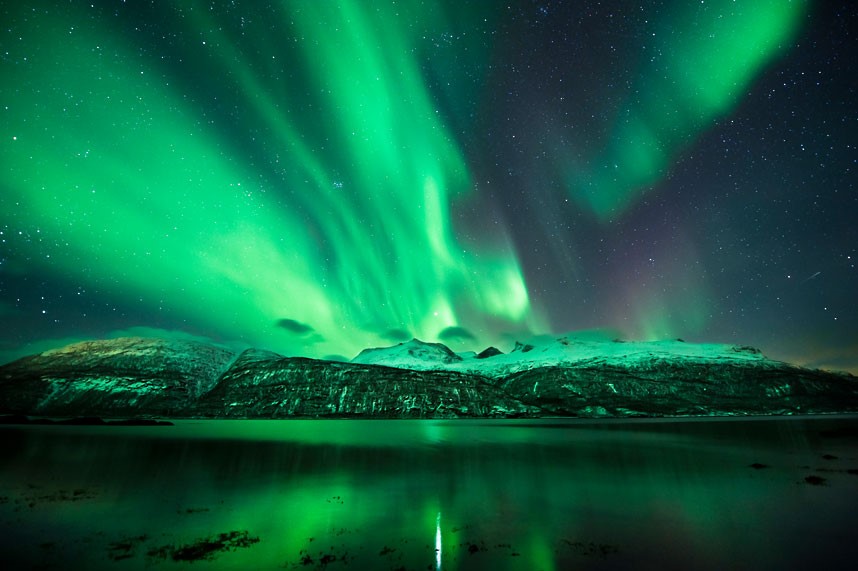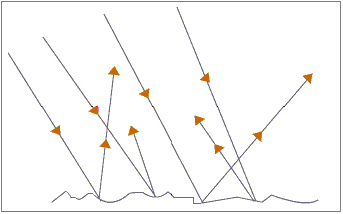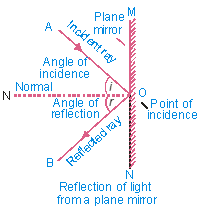It is a matter of common experience that the objects inside a dark room, which are invisible, become visible when the room is illuminated by a source of light. Thus light can be defined as the external cause responsible for the sensation of vision. The branch of Physics dealing with the nature and properties of light and vision is called optics.

Light travels very, very fast. The speed of light in a vacuum (an area empty of matter) is around 186,000 miles per second (300,000 kilometers per second).
Isaac Newton observed that a thin beam of sunlight hitting a glass prism on an angle creates a band of visible colors that includes red, orange, yellow, green, blue, indigo and violet (ROYGBIV). This occurred because different colors travel through glass (and other mediums) at different speeds, causing them to refract at different angles and separate from each other. Light travels slower through different mediums such as glass, water and air. Relative speed of light for different medium described with the help of refractive index of the medium.
Also Check: Force
Definition of Light
Light is a form of invisible energy which produces the sensation of sight. The object which emit light are known as sources of light or luminous object. A ray of light is a path followed by light energy in a transparent medium. A group of parallel rays of light emitted by the source of light is called beam of light.

Nature of Light
Light is a form of energy and can be transformed into other forms of energy. We could observe the path of 'a beam of light' inside a room. This beam is nothing but the scattered light produced by the dust particles and this beam of light becomes invisible if the room is dust free. Thus light makes things visible even though light by itself is invisible.
Light does not require a material medium for its propagation. In a given medium light travels with a very high but finite velocity. The velocity of light in air or vacuum is 3 x 108 m/s. Velocity of light in different material is different but less than that of in vacuum depending upon the properties of the medium.
 Do you know?
Do you know?
Aurora Borealis. It is nature’s own spectacular fireworks show on display in the colder places on Earth. Green light get scattered over sky and thus create a beautiful scene.
Reflection of Light
When a ray of light falls on any surface, a part of the light is sent back to the same medium. This phenomenon where the incident light falling on a surface is sent back to the same medium is known as reflection.
Also Check: Sound
There are two types of reflection of light:
- Regular reflection
- Irregular reflection
Regular Reflection

Regular Reflection on a Smooth Surface
Regular reflection takes place when a ray of light is incident on a polished smooth surface like a mirror. Here the reflected ray of light moves only in a fixed direction.
Irregular Reflection or Difused Reflection

Diffused Reflection on a Rough Surface
Irregular reflection or diffused reflection takes place when a ray of light is incident on a wall or wood, which is not smooth or polished. In this case, the different portions of the surface reflect the incident light in different directions. In such cases no definite image is formed, but the surface becomes visible. It is commonly known as scattering of light. Thus diffused reflection makes non-luminous objects visible.
Also Check: Thrust & Pressure
Not all light, which hits an object, is reflected. Some of the incident light is absorbed. The brightness of an object depends on the intensity of the incident light and also on the reflectivity of the object.
If a surface allows the entire incident light to undergo regular reflection then it will become invisible.
Reflection of a light by a Plane Surface
The figure shows how a ray of light is reflected by a plane surface. Let MM' represent a reflecting surface. When a ray of light is incident on MM' in the direction IO it gets reflected along the direction OR. IO is the incident ray; O is the point of incidence and OR is the reflected ray.

Let ON be the normal drawn perpendicular to the surface MM' at the point of incidence. The angle which the incident ray makes with the normal at the point of incidence is called the angle of incidence and is denoted by the letter 'i'. The angle that the reflected ray makes with the normal at the point of incidence is called the angle of reflection and is denoted by the letter 'r'. Mirror is an example of a reflecting surface. The angle of deviation is angle by which the incident ray deviate from the path.
Also Check: Waves
THE LAWS OF REFLECTION
The reflection at any plane surface is found to obey the laws of reflection. The laws of reflection are:
- The incident ray, the reflected ray and the normal at the point of incidence lie in the same plane.
- The angle of incidence is equal to the angle of reflection.
i.e. 
Ques 1: For an angle of incidence i. What will be the angle of deviation.

Solution: Given angle of incidence = i
Angle of deviation = d
Consider the straight line AOE,
i + r + d = 180o
d = 180 – (i +r)
= 180 – (i + i)
= 180 – 2i
Therefore for an angle of incidence i, the angle of deviation is equal to 180 - 2i.
Ques 2: The maximum angle of deviation possible for a ray with a plane mirror is?
Solution: Suppose maximum angle of deviation is d.
If the angle of incidence of a ray on a plane mirror is ‘i’,
the angle of deviation d=180-2i
Value of angle of deviation is maximum, when subtracting quantity ‘2i’ is minimum.
i.e., i =0o
i.e., d = 180o - 0o
Therefore the maximum angle of deviation possible for a ray undergoing reflection from plane mirror is 180o
Also Check: Frictional Force
Frequently Asked Questions
Light is the type of energy that our eyes can see. It helps us see things around us. Light travels in a straight line from one place to another.
Light is a type of energy that brightens things, whether it comes from the sun or a lamp. The word "light" can be used in different ways—it can describe something that is bright or not heavy.
The characteristics of light include bending (refraction), bouncing off (reflection), spreading out (diffraction), merging (interference), breaking into colors (dispersion), aligning waves (polarization), and scattering.
Light is a form of energy that our eyes can detect. It allows us to see what's around us.
Related Links
| S.no | Formulas List |
|---|---|
| 1. | Force |
| 2. | Frictional Force |
| 3. | Thrust and Pressure |
| 4. | Buoyant Force |
| 5. | Waves |
| 6. | Sound |
| 7. | Some Natural Phenomena |
| 8. | Electroscope |
| 9. | Lightning |
| 10. | Earthquake |